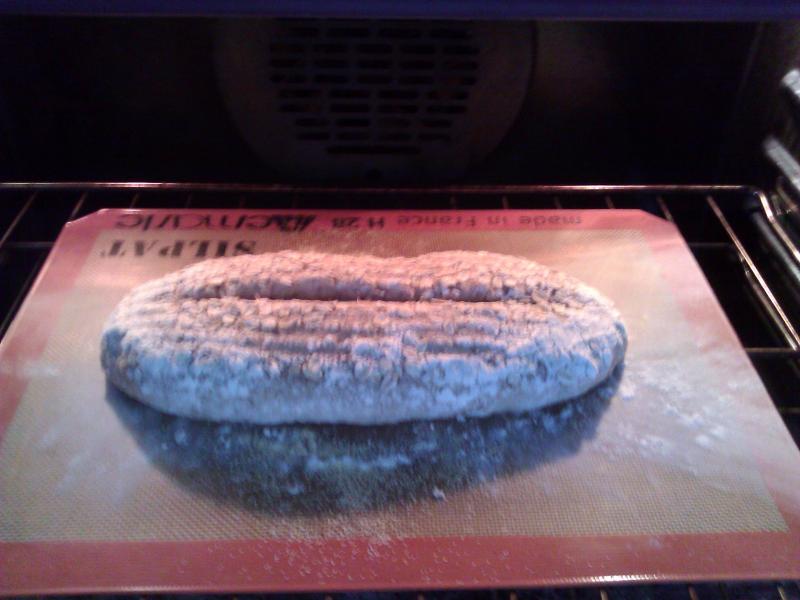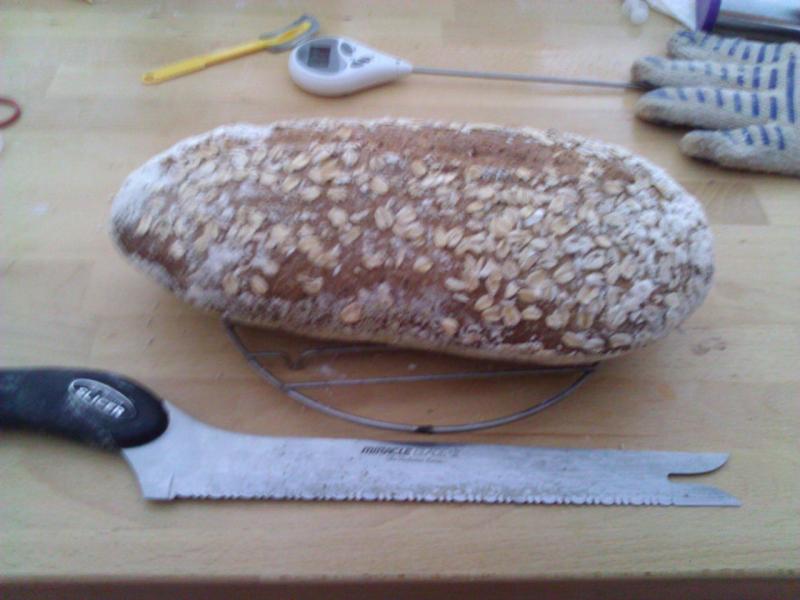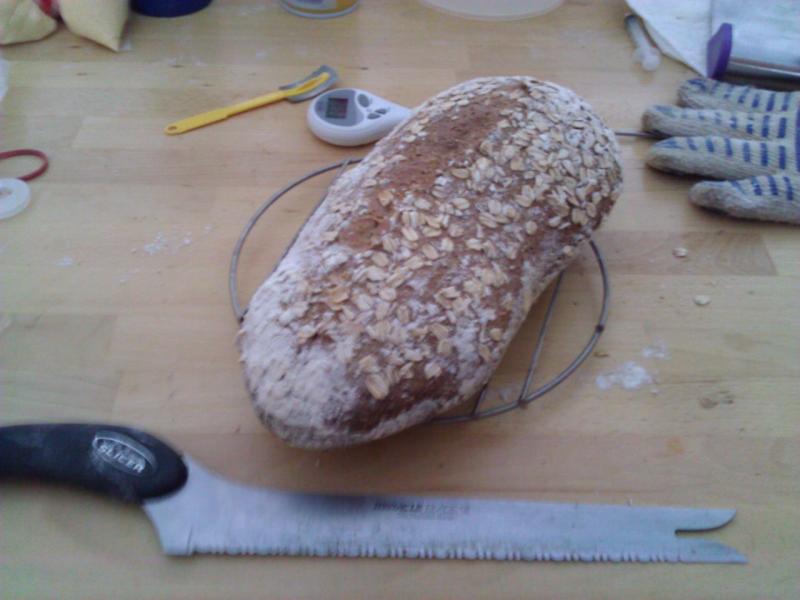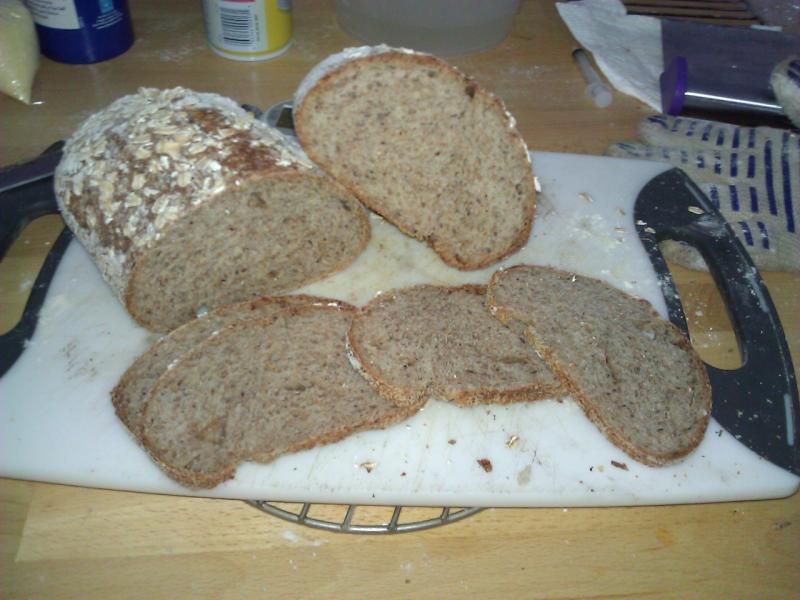Levain:
- 100% WW starter at 100% hydration, total 30g
- Fed 15g WW, 15g Water, put in smoker @ 92F for 4 hours
- Fed 30g WW, 30g Water, put in smoker @ 92F for 2 hours
- Fed 75g WW, 75g Water, put in smoker @ 92F for 2 hours
- Reserved 30g of starter as mother
Dough Ball:
- Combined 94g rolled oats, 300g WW, 10g milled flax, 285g boiling water and put in smoker @ 92F for 4 hours
- add 12g salt
- KA'd @ Speed 2 with cookie hook for 2 minutes (or until the mass isn't being beaten any more)
- KA'd @ Speed 2 with dough hook for 5-10 minutes (or until sides and bottom of the bowl are cleared)
- Put back into the smoker @ 92F for another 4 hours (take out at the same time the levain is ready)
Loaf:
- Combine dough ball and levain
- KA'd @ Speed 2 with cookie hook for 2 minutes (or until the mass isn't being beaten any more)
- KA'd @ Speed 2 with dough hook for 5-10 minutes (or until sides and bottom of the bowl are cleared)
- S&F, then retard @ 36F for 60 minutes
- S&F, then retard @ 36F for 60 minutes
- S&F, then I retarded it overnight @ 36F
- In the morning, I S&F and then put it in the smoker at 80F for 45 minutes (some rise)
- S&F and put it back in the smoker at 80F for 45 minutes (some rise)
- S&F, put rolled oats into floured banneton, then the loaf, let it proof at RT (75F) for 75 minutes (no noticeable rise)
- I then put it in the smoker at 80F for 45 minutes (no additional rise)
- Scored and baked @ 375 for 50 minutes (no stone, no steam)

In the oven, ready to bake.

No oven spring, I'm pretty sure I have over-proofed.


So the crumb isn't what I had hoped for. I would've liked it to be a little more open. It is not heavy, however. It is very tasty, but I made a loaf yesterday without the rolled oats and there is surprisingly little taste difference between them.
My estimate on nutritional info (42.5g)
- Cal: 159.14
- Fat: 1.39
- Carb: 29.20
- Fiber: 4.42
- Protein: 5.79
All in all, not a bad bread. The recipe I derived this from included 1/2 cup of honey and 1/2 cup of oil, which I choose to omit. That author claimed the loaf should rise well, perhaps that's why mine didn't do as well?
I think your bread was overproofed when you put it in the oven. I wonder that it rose at all in the oven. Why did you S&F it again (and even twice!) after the bulk retardation?
Karin
I agree, it was over-proofed, but I don't feel the S&F's did any harm, that is how I have been baking my breads. An overnight retard, then S&F's...?? When do you do S&F's?
FWIW Muskie, when I started baking oat sourdough bread, at first with oat flour then shifting to oat bran, like you I used whole wheat flour. I used the same technique as for my (always successful) white sourdough. That first oat loaf was a total flop. A brick so sour I had to throw it away. Not to mention that the dough was not easy to handle. Second loaf: the dough just disintegrated through my fingers! Then I read that flax could help. So I added some flax powder. Same problem. That's when I started to do some research in those fields that should not be named ;-)
In light of your description of the techniques you used and of the stuff I have been reading, I can think of a couple of things that I do differently when preparing my oat sourdough bread: 1) when working with oats, do not overwork the dough; 2) when using whole wheat with oats, beware of wheat bran: there's an optimal amount that some have found to be hovering around 3%. Add more and the bread will be dense.
Since I am still at the beginning of my journey on the oat sourdough bread baking, I cannot vouch that the above points are 100% correct. Perhaps some bakers have the necessary experience to overcome the difficulties of bread baking with oats.
Cheers!
Way better than I could have done! I would totally make a sandwich with this :)
Like Heath said, usually S&F's wouldn't be done after development and ferment. I know that some folks might do 1 or 2 more if they are bulk retarding the first 2 hours. Over working the dough will give you a tight crumb especially after the ferment period. Still your bread really came out great and has to be a tasty sandwich loaf.
Thanks all. It is absolutely delicious, and makes great sandwiches. I've been working on Ciabattas the last couple of days which I now feel may be a better loaf for me...but that's another story.
Does anyone have a recipe that is intended to help me learn gluten strength? Is that what the "window pane test" or "poke test" are for, to determine gluten strength? I really feel like I've missed a crucial initial learning point.
proves no kneading is really necessary if you have a lot of time to let the gluten develop on its own, lack a mixer are physically not able likw some I work with, or just plain lazy to do it.
I like to get new balers to make bread using slap and folds in 3 sessions 7, 2 and 1 minute each with 12 minutes in between so that they get the feel of the dough and gluten development at various hydration levels and different grains. And then do 3 or 4 sets of stretch and folds on 12 minute intervals when one set is pulling and folding over from the 4 compass points only so that they cam feel the dough tighten up. Then just leave it alone to ferment all on its own depending on the recipe instructions. I believe that manipulating the dough more than 2 hours after the mix can easily make tie bread have a closed crumb and tougher structure. At least that is my experience. I never check for window pane for a mutigrain or high % whole grain bread I usually make. But will do so on panettone and other enriched dough, white baguettes low % whole grain near white breads and white breads with higher hydration - the rest you can just feel close enough.
Learning to feel the dough to know where it is for gluten development, shaping and knowing when the dough has final proofed to 85%, scoring and having the oven just hot at that time are the most important things in bread making for me.
Happy baking
S&F is a technique that makes long kneading superfluous. As Heath said, you do it after a fairly brief kneading, at intervals. Every fold supplies the sourdough organisms with fresh flour/food, and strengthens the gluten, a task that would otherwise be achieved by longer kneading.
For example, Ken Forkish ("Flour, Water, Salt, Yeast") works the dough very briefly, and then does 3 - 4 folds, the first 2-3 within 2 hours after mixing, the last fold before going to bed. The next morning he handles the fermented dough very gently not to degas it.
Peter Reinhart ("Artisan Bread Every Day") mixes the dough 1 minute to hydrate the flour, then puts in 5 minutes autolyse, followed by 6 minutes kneading. Then he does 4 S&Fs, at 10 minute intervals (total time 40 minutes) After the last fold the dough goes in the fridge and is left in peace.
If you fold the fully fermented dough again, it will deflate, and has to rise again. At some point its potential to rise is exhausted, and the bread will be dense, without oven spring.
When you start out, I would always advise you to try first proven, uncomplicated recipes, without too many variables, so that you have predictable results.
Karin
Thanks hanseata! I've cut, pasted & saved it for reference. It is so helpful to have those various techniques neatly stored within one's brain to be accessed depending on the behaviour of the dough or the bread one wants to bake.
Did I mention that my first loaves were bricks, because I had no instructions and no good book to learn from? And that was before TFL was born.
Happy baking,
Karin
importance of hemp seeds.....
Lucy is worried about the Queen of Seeds. Thankfully today, you have more bread books in more languages than my apprentice does but, my apprentice can't read, is bred to be stupid first and foremost.... and only barks German :-)
How could I forget those? If Lucy barks at me now I deserve it. To win back her favor I have to bake Nils Schöner's Pain au Levain with Walnuts and Hemp Seeds again.
Ruefully,
Karin
Hemp, walnut Sourdough sounds great!